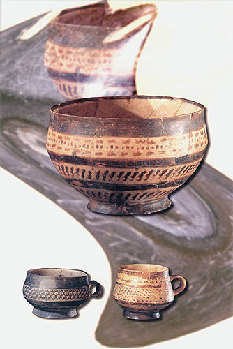Archaeological site of the Neolithic Age
Location:WushanCounty,Chongqing
Period: 4400-3300 BC
Excavated from 1925 to the present
Significance: The Daxi Culture is named after the site. It is the first find of the Neolithic culture in the middle reaches of theYangtze River.
 Introduction
Introduction
Daxi Site, located at the eastern outlet of the Qutang Gorge in Daxi town ofWushanCounty, is the origin of theYangtze River's ancient culture. It's the important site ofChina's matriarchal Neolithic Age. On the west of Daxi town, there is a stream flowing intoYangtze River. It is named Daixi because of its dark green water.
 |
| Painted pottery bowl: food container (up-mid, height 6.6 cm); Painted pottery cup with single ear: water vessel (left-bottom, height 6 cm; right-bottom, height 8.5 cm) |
Daxi Culture, one of the earlier cultures of Neolithic Age originated over 5,000 years ago. From 1959 to 1975, archaeologists had three large excavations here, with an excavated area of 570 square meters. The artifacts unearthed from these graves show that the spot was a Neolithic site where people lived in Matriarchal clan communes during the late period of the primitive society.
The two excavations have revealed a cultural stratum that held a great abundance of artifacts, including pottery, stone, bone and jade ware as well as many fish bones and animal horns. Among the pottery articles, red pottery was predominant. Next came to gray and black pottery. The pottery was decorated with designs including rope impressions, horizontal V designs and net and feather designs. Most of the stone implements were stone axes, but there were also a smaller number of stone adzes, hoes, chisels and discs.
The excavation since 1959 has covered an area of 853 square meters and yielded 208 ancient tombs and 1,250 articles of historic relics. All this shows that there were three kinds of social divisions of labor here: farming and fishing and hunting.
Valuable objects have been provided for the study of the society, the farming, the handcraft industry, the religion and the art in the Neolithic Age in the basin of the river, filling the blank between Yangshao Culture and Qujialing Culture in the central and lower reaches of the river.
